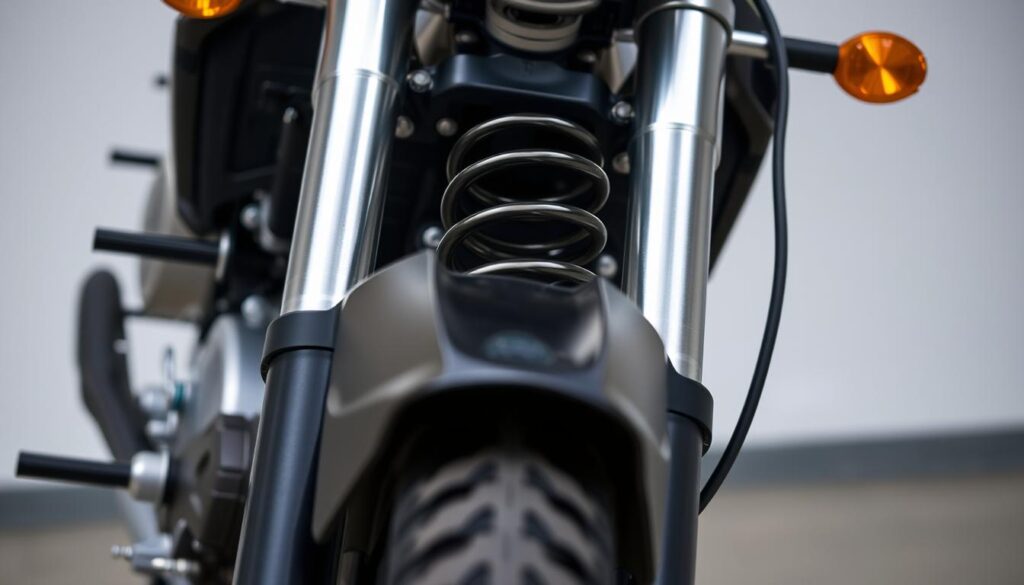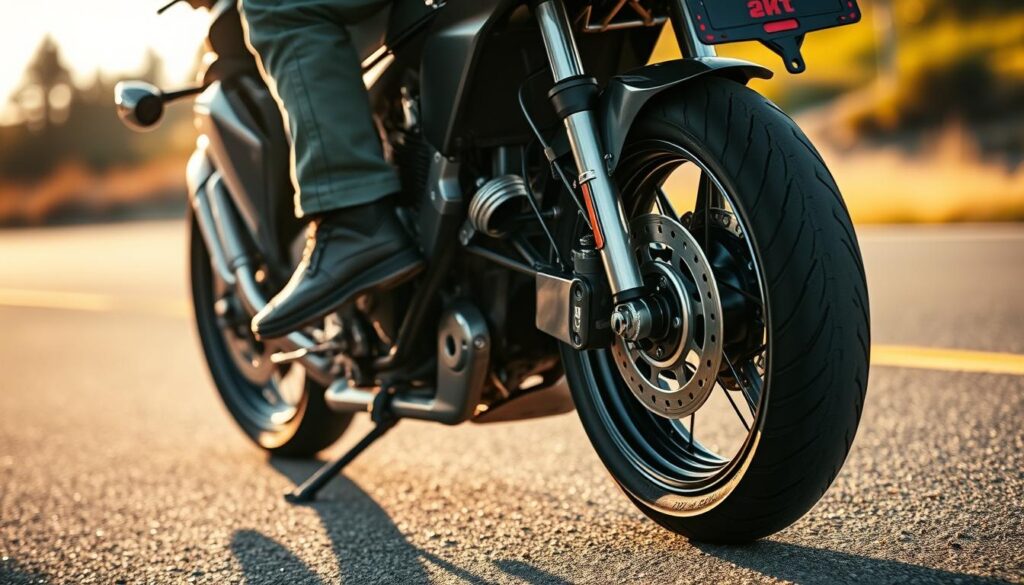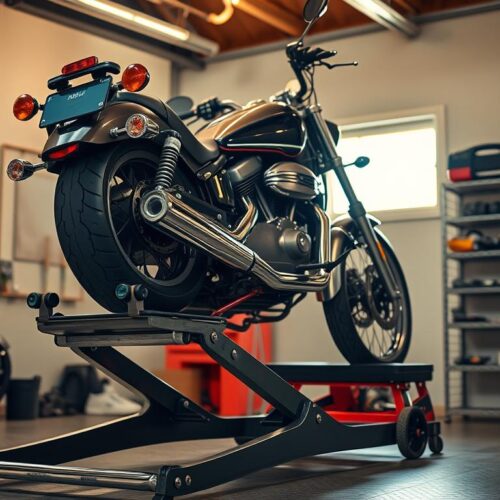Motorcycle suspension adjustment is crucial for a great riding experience. It boosts comfort and ride quality. This helps you stay safe and in control on different roads. Knowing how to adjust your motorcycle’s suspension gets you the best handling. This guide will show you how to tweak your suspension. You’ll learn how to make your ride smoother and perform better.
Understanding Motorcycle Suspension Basics
The motorcycle suspension keeps your ride smooth and quick to react. It keeps the tires touching the ground and soaks up road bumps. Knowing the basics of motorcycle suspension shows you how its parts work together to improve your ride.
Most motorcycle suspensions have a coil spring and a hydraulic damper. These parts handle weight shift when you speed up, slow down, or turn. This gives you stability and control. Springs can be linear or progressive, affecting how your ride feels. Linear springs react the same through their whole compression. Progressive springs get harder to compress, changing with different conditions.
Different riding styles need different suspensions. Road bikes aim for a comfy, smooth ride. Off-road bikes need to handle big bumps and rough ground. Choosing the right suspension for your bike’s purpose boosts its performance, safety, and fun.
| Component | Description | Function |
|---|---|---|
| Spring | Coil spring, either linear or progressive | Absorbs bumps and maintains tire contact |
| Hydraulic Damper | Fluid-based damping mechanism | Controls the rate of suspension movement |
| Suspension Linkage | Connects suspension components | Facilitates movement and geometry |
Importance of Proper Suspension Adjustment
Adjusting your motorcycle’s suspension is key to better performance and safety. It helps with more than just avoiding discomfort. Properly set suspension improves how your bike handles and how well it grips, especially on different surfaces.
Most motorcycles come with a one-size-fits-all suspension. It might not suit your weight, height, or how you like to ride. Making it fit you right means a smoother ride. And, with the suspension tuned for you, your bike deals better with changes, boosting your confidence and fun on every trip.
Ignoring your suspension can make for a rough or mushy ride, messing with your control. This can make riding, especially turning or stopping suddenly, risky. Custom tuning your suspension keeps you safe and comfortable, no matter the ride conditions.
Tools Needed for Suspension Adjustment
Gathering the right motorcycle suspension tools is crucial. You will need a tape measure, a preload adjustment tool known as a C-spanner, and your bike’s manual. These tools help set up your suspension right. They ensure you follow your motorcycle’s specific requirements.
Don’t forget about wrenches and allen keys. They’re necessary for adjusting bolts. A digital sag measuring tool is also a key addition. It simplifies measuring sag accurately and quickly.
| Tool | Description | Purpose |
|---|---|---|
| Tape Measure | A flexible measuring device | Used to measure rider sag and overall suspension travel |
| C-Spanner | A tool designed to adjust suspension preload | Used for adjusting the preload on the shock absorbers |
| Wrenches and Allen Keys | Essential tools for various bolts | To tighten or loosen suspension components |
| Digital Sag Measuring Tool | An electronic device for precise measurements | To accurately measure static and rider sag |
| Motorcycle Manual | A reference book for your specific bike model | To understand specific settings and recommendations |
How to Adjust Front Suspension
Adjusting your motorcycle’s front suspension improves performance and comfort. Start by measuring the sag accurately. To do this, sit on your motorcycle as you normally would. Let the suspension compress under your weight. Measure the distance from the rear axle to a fixed point on the rear fender. Then, do it again with the bike on a stand. The difference between these measurements is your sag, which should be 30mm to 40mm.
After measuring the sag, adjust the preload settings. You can do this using the adjustable collars on your forks. By turning the collars, you can either increase or decrease preload. Do this until you get the right sag. This adjustment is vital for setting up your suspension. It should match your weight and how you ride.
With the proper sag set, it’s time to fine-tune your front suspension. Focus on damping, which includes both compression and rebound. Compression damping affects how your suspension compresses. Rebound damping controls how it extends back out. Begin with the settings your bike’s manufacturer suggests. Then, make minor changes to find what works best for you. Adjusting your front suspension this way will make your ride feel a lot better.

How to Adjust Rear Suspension
Adjusting your motorcycle’s rear suspension is key to better comfort and control. Start by measuring the sag properly. With the motorcycle unloaded, measure from the rear axle to a fixed point on the bike. Then, sit in your riding position and measure again. The difference is your sag amount. For best performance, aim for a sag of 25mm to 40mm. This depends on how you ride and the type of motorcycle you have.
After measuring your sag, it’s time to adjust the preload on the rear shock. You’ll usually need a special tool for this. Turning the collar on the shock clockwise often increases preload. This helps you get the right sag. Remember to make small adjustments and check your sag again each time. This way, you won’t go past your goal.
Next, tweak the damping settings to fine-tune the suspension. Adjusting rebound and compression damping changes how the shock acts over bumps and in turns. Start with small tweaks and test ride your bike after each one. Doing this improves rear wheel traction and riding comfort. It ensures your bike is at its best in any situation.
Setting Up Your Motorcycle for Different Conditions
Changing your motorcycle’s settings for different conditions makes riding safer and more enjoyable. Each type of ride might need special tweaks for the best performance. For example, rough routes call for adjusting your suspension to handle tricky spots better. This way, your motorcycle becomes more versatile on changing surfaces.
Don’t forget to adjust for passengers or extra gear, too. Changing the preload settings is key when you have a companion or heavy luggage. This affects how high your bike sits and its response to different road conditions. Riding alone? Lowering preload might improve comfort. But with a passenger, higher preload keeps the ride smooth and stable.
Adjusting your motorcycle for the terrain is about perfect handling. First, think about the roads you’ll meet. Soft settings work for smooth paths, but you’ll want a firmer suspension for bumpy roads. Finding the right setup helps you switch between conditions without a hitch.
Common Suspension Adjustment Mistakes
Riders often make mistakes when adjusting their suspension. One major mistake is not checking sag measurements right. If you skip this, your motorcycle’s handling and comfort can suffer. It’s key to measure sag first, before changing settings.
Another mistake is overlooking rider weight and extra loads. This oversight can hurt how comfy you feel on your bike. Keep in mind, the best setup for your motorcycle changes with different weights onboard.
Being consistent with adjustments is also important. You should always note down the changes you make and test them. If you don’t, you might end up with a bike that’s less fun to ride. Avoid these errors to improve your motorcycle’s handling and grip.
Testing Your Adjustments
After you tweak your motorcycle’s suspension, testing the changes is key. A test ride will show you how your motorcycle feels in real-world situations. Notice how comfortable you feel and how well your bike grips the road during the ride.
While riding, keep track of how the adjustments make a difference. Ask yourself, is the ride smoother? Does the suspension deal with bumps better now? Think about these points to make sure the setup fits what you like and how you ride. If it’s not up to your standards, you might need to fine-tune things for the best control.

Frequently Asked Questions about Suspension
If you have a motorcycle, you probably have questions about the suspension. Suspension FAQs clear up common issues riders face. Knowing the basics can make riding much better.
One big issue is knowing when and how to adjust your suspension. Changes in weight or riding conditions can affect your ride. Tweaking the preload, compression, and rebound settings can make your ride smoother and more controlled. If you’re not sure, ask an expert.
Regular maintenance is also crucial. Keeping suspension parts clean and well-lubricated matters a lot. Check regularly for leaks or damage. Ignoring your suspension can lead to safety issues and worse performance.
Knowing the common suspension issues can help you make smart choices. Here’s a brief overview:
| Issue | Symptoms | Solution |
|---|---|---|
| Leaking Fork Seals | Oil on forks, handling issues | Replace seals; check fork oil level |
| Rear Shock Fade | Loss of dampening, instability | Rebuild or replace shock |
| Incorrect Preload Settings | Bouncing, uncomfortable ride | Adjust preload according to manual |
These tips can help you manage your suspension better. Use maintenance guides and expert advice to keep your ride smooth and safe.
Signs You Need a Suspension Adjustment
Spotting the need for a suspension adjustment is key to keeping your bike running smooth. Keep an eye out for signs like too much bounce while riding. This could mean the suspension needs tweaking if your ride feels rough.
If your bike handles poorly when you brake or speed up, it’s time to check the suspension. Too much dive during braking or instability when accelerating can make your ride less safe and enjoyable.
Also, pay attention to how much your motorcycle sags when you sit on it. It shouldn’t sag more than what the maker says is okay. If it does, or doesn’t bounce back after a ride, it’s time to adjust the suspension. This keeps your ride safe and fun.
The Impact of Weight on Motorcycle Suspension
Weight is key in how motorcycle suspension works. Changing your setup for different rides is important. This includes riding alone, with someone, or with extra gear. Each change affects the bike’s balance and how the weight impact influences suspension.
Adjusting the suspension preload is crucial for the right sag. It affects ride height and handling. Knowing how rider weight changes suspension can make rides more enjoyable. If you add weight, you may need to adjust your suspension. This prevents it from being too stiff or bottoming out.
Always check and tweak your suspension for comfort and control. See how different weights change how your bike rides. Making these adjustments for your riding style is key. This way, your motorcycle is always ready to perform well.
When to Seek Professional Help
Getting to know how motorcycle suspension works is tough. Knowing when to ask for professional help is key for staying safe. If fixing your suspension doesn’t work and you still have problems like too much bouncing or not feeling steady, it’s smart to talk to an expert. They have the right know-how and tools to find and fix what’s wrong.
At times, fixing things might be trickier than it seems. If you’re not sure what settings fit your way of riding or your weight, or if adjusting preload or damping feels hard, it’s good to seek expert advice. They can give you customized tips and fixes to make your bike run better.
Putting your safety first means knowing when to get help from a pro. Having an expert look at your bike ensures it stays in great shape. This lets you ride with ease every time. So, if you’re stuck with a problem you can’t fix, don’t wait to call a skilled technician or suspension pro.




